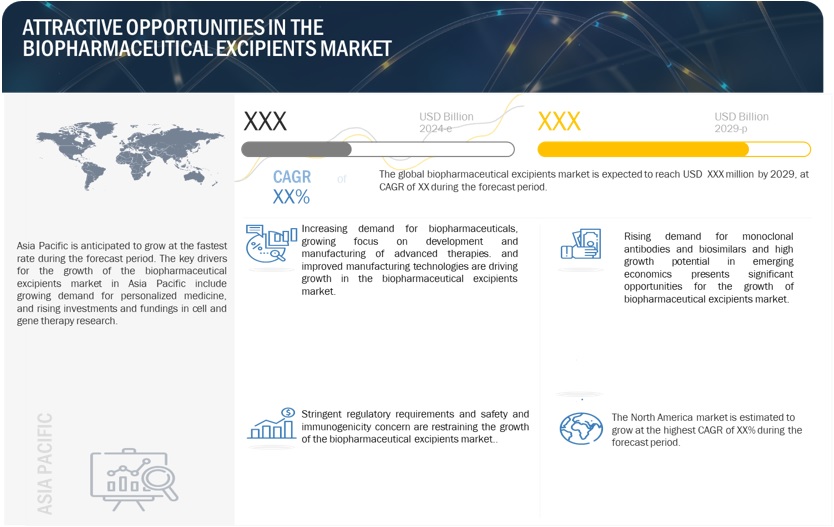Biopharmaceutical Excipients Market - Global Forecast to 2029
The global biopharmaceutical excipients market accounted for USD XX billion in 2023. It is projected to reach USD XX billion by 2029 from USD XX billion in 2024, at a CAGR of XX% during the forecast period. The major factors driving the growth of this market are rising demand for biopharmaceuticals, growing focus on development and manufacturing of advanced therapies such as cell and gene therapy, and personalized medicines, and increasing R&D spendings for biopharmaceutical production. Additionally,improved manufacturing technologies such as automated systems, countinuous manufacturing, and more efficient purification processes is propelling the growth of biopharmaceutical excipients market.
Attractive Opportunities in Biopharmaceutical Excipients Market

GLOBAL BIOPHARMACEUTICAL EXCIPIENTS MARKET DYNAMICS
Driver: Rising R&D spendings for biopharmaceutical production
As the biopharmaceutical industry continues to evolve, the demand for advanced technologies that can support the production of biologics, such as vaccines, monoclonal antibodies, and gene therapies, has risen. The surge in R&D investments is leading to the development of novel drugs, therapies, and vaccines, particularly in the biopharmaceutical sector. As the biopharmaceutical products market expands and diversifies to meet the growing demands of healthcare and life sciences, it fuels the growth of biopharmaceutical excipients market.
Biopharmaceutical companies are investing heavily in discovering new biologics that require specialized excipients to ensure the stability, solubility, and delivery of these complex therapies. As drug formulations become more advanced and personalized, the demand for innovative excipients grows to address the unique needs of these drugs, such as enhancing bioavailability, ensuring drug release profiles, or protecting sensitive molecules. This surge in R&D spending pushes excipient manufacturers to develop new and more sophisticated excipients, contributing to market expansion.
Restraint: Stringent Regulatory Requirements
The biopharmaceutical industry is highly regulated due to the potential risks to patient safety and health. Regulatory bodies like the FDA, EMA, and others require comprehensive testing and validation of both active ingredients and excipients to ensure safety, efficacy, and stability. The approval process for excipients used in biologic drugs is complex and time-consuming, which can delay product development and market entry. New or novel excipients, particularly those for advanced therapies like gene or cell-based treatments, face additional scrutiny due to limited precedents, further delaying market entry. Compliance with Good Manufacturing Practices (GMP) and the ongoing costs of regulatory documentation and surveillance also place a financial burden on excipient manufacturers, hindering their ability to rapidly innovate and bring new products to market. These regulatory hurdles create uncertainty, increase development costs, and slow the pace at which new excipients can be integrated into biologic drug formulations.
Opportunities: High growth potential in emerging economics
Healthcare access is expanding in emerging markets, leading to increased demand for biologics. Countries in regions like Asia-Pacific, Latin America, and Africa are experiencing growth in their biopharmaceutical sectors, creating a demand for excipients that can support the production of biologics. This includes the need for excipients in vaccines, monoclonal antibodies, and other biologic treatments that are critical for addressing public health issues. Developing countries in the Asia Pacific region have also attracted companies seeking to capitalize on their low cost of manufacturing. Moreover, the increasing interest of pharmaceutical companies in drug discovery outsourcing due to the ever-increasing demand for vaccines, drying antibiotics pipelines, and rising R&D costs further fuel the growth of biopahramecutical excipients in emerging markets.
Challenge: Complexities in biopharmaceutical excipients manufacturing
Biopharmaceutical excipients must be carefully designed to meet the unique demands of biologic drug formulations, which often involve highly sensitive and intricate molecules like proteins, nucleic acids, and lipids. These excipients must be compatible with the biologic drug’s active pharmaceutical ingredients (APIs) while ensuring the stability, solubility, bioavailability, and targeted delivery of the drug. This complexity requires excipient manufacturers to develop sophisticated formulations that can maintain the integrity of biologic therapies under varying conditions, such as temperature fluctuations and long shelf lives. The need for excipients that work across a wide variety of biologic platforms, including monoclonal antibodies, gene therapies, and mRNA-based drugs, further compounds this challenge.
Additionally, excipient development for biologics often involves trial and error to identify the right combination of ingredients that can meet stringent regulatory, safety, and performance standards. This complexity leads to longer development cycles, higher R&D costs, and the requirement for specialized expertise in formulation science. For example, excipients for gene therapies or cell-based therapies need to protect fragile genetic material, ensure targeted delivery, and reduce the risk of immunogenic reactions, which can be challenging. As a result, the intricate and often customized nature of biopharmaceutical excipients creates significant barriers to entry for new manufacturers, slows down innovation, and drives up production costs, limiting the market’s growth potential.
Key Market Players
- Evonik Industries AG (Germany),
- BASF Corporation (Germany),
- DFE Pharma (Germany),
- Pfanstiehl, Inc (US),
- Roquette Frères (France),
- Actylis (US),
- The Lubrizol Corporation (US),
- Clariant (Switzerland),
- Nagase Viita Co., Ltd. (Japan)
Recent Developments:
- In June 2025, Nagase Viita Co., Ltd. is expected to expand the line of SOLBIOTE, saccharide-based pharmaceutical excipients, with the launch of high-purity and low-endotoxin SUCROSE SG. SUCROSE SG will offers a comprehensive range of solutions for stability in biopharmaceutical development.
- In November 2024, Clariant launched VitiPure LEX 3350 S, VitiPure LEX 4000 S, and Polyglykol 1450 S to solve API delivery and bioavailability challenges.
To speak to our analyst for a discussion on the above findings, click Speak to Analyst

Biopharmaceutical Excipients Market















Growth opportunities and latent adjacency in Biopharmaceutical Excipients Market